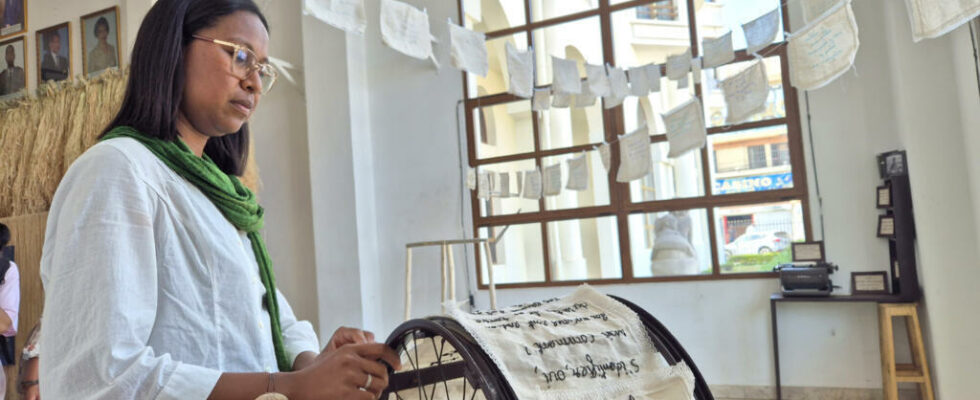How to commemorate Malagasy women? How to allow them to tell their stories, to re-appropriate history through their own stories? In Antananarivo, an exhibition and a festival both called “Vavy” (“women” in Malagasy) are taking place until September 21, 2024 in different locations in the capital. Illustration at the City Hall with the exhibition called “Vavy, the archives of our lives”.
3 min
With our correspondent in Antananarivo, Sarah Tétaud
” Woman of Africa, child of the world, keep your roots in your entrails. Whoever dares to force you to show them to prove them, you will ignore them. Thus you will survive. » Here, verses that escape from a word mill, which the visitor can turn endlessly. There, suspended on a thread, words that seem to fly away. The poet Na Hassi presents an artistic installation inspired by expressions that she has chosen to take literally. Words with which she plays, with which she also plays, the very ones that often lock women into straitjackets. There are stories that are not very clean, but they are stories of women that we try to stifle on a daily basis and I spread them out here.she explains. Yet there are truths that are killing us in silence and that perhaps we should talk about.. Teasing is more violent, more hurtful than punches. »
Facing the Word millhuge portraits of women, painted by Joey Arisoa, another artist. Women whose pose inevitably recalls that of the photographs taken for the colonial archives. It was a way to study them, to categorize them.recalls Joey Arisoa. And so I take up these ways of posing in the archives, with also their traditional attributes (fabric, braid, etc.) that we used to better catalogue, as if to revive what we were like 100 years ago, but also to add life to it, to perhaps bring a dignified and more embodied look, and with my share of things to say. “.
In front of the painting, Tsiry, a visitor, does not move, as if captivated. Accompanied by his mother, his wife and their daughter, they contemplate together the work with its bluish hues. I, as a man, am amazed because there are many, many messages in this painting.he reacts. You know, I’m not used to exhibitions. It’s even my first time! I come from the provinces and these are not places I usually frequent. “.
One after the other, the visitors question Joey Arisoa. The way she conceived the work, by making infusions of her poems to create this blue tint, by having the models pose with attributes reserved for men when they speak, the gesture that the model makes, with her fingers, it’s very interesting.Tsiry enthuses. I would never have understood all this if I had not been able to speak with the artist! »
The model posing in front of the artist signs the word “echo” with her hands. Echo as the genesis of this exhibition. To carry far the voices of these women whose history has been erased, and to allow ourselves, as artists, to speak when ordinarily, it would first be necessary to leave it to men.
Vavy Festival of Antananarivo: “It is important to use art and culture to raise awareness of the cause of women”
This festival, created by women and inviting women to tell their stories, is a first of its kind in Madagascar. Until Saturday, in various locations in the capital, free events invite the public to come and listen, learn, discuss and question the representation of Malagasy women, our environment and our society with the guests of this festival: contemporary personalities, artists, thinkers, opinion leaders, writers, filmmakers, historians, who in their practice, in their daily lives, constantly question the place and role occupied by the feminine gender.
Hannah Abdullahi, researcher and doctoral student in gender and development, founder of the Vavy Festival, underlines: “ It was important for me to use art and culture as a way to raise awareness about women’s causes. And especially their representation, because we mostly think of a Malagasy woman when there are Malagasy women: there is a great diversity and that is also what we really wanted to highlight. And also highlight women that we do not necessarily think about, women who have existed, but whom we never talk about even though they contribute or have contributed to our society. »
She continues: “ So, in fact, the Malagasy woman, when she is represented, she is already not often represented, but when she is, they are always personalities. And what we wanted to highlight are women who have greatly contributed to the cultural scene of a country, that we should know. And yet, they have been forgotten. So it was really about putting that forward, so that people learn their history. So that people start to ask themselves questions: “Why don’t we actually talk about these women?”
